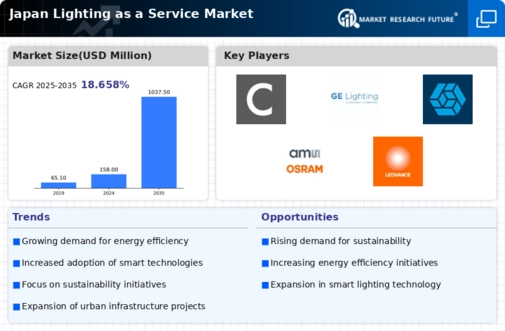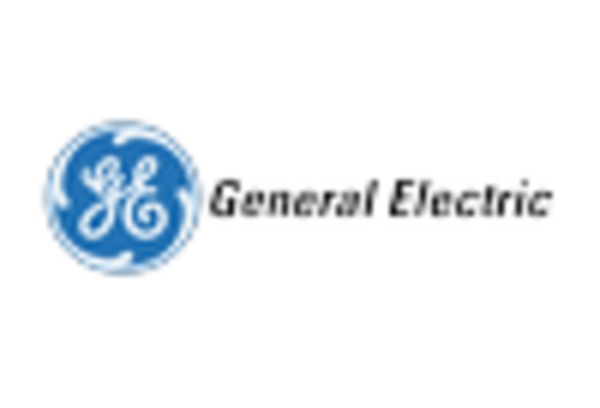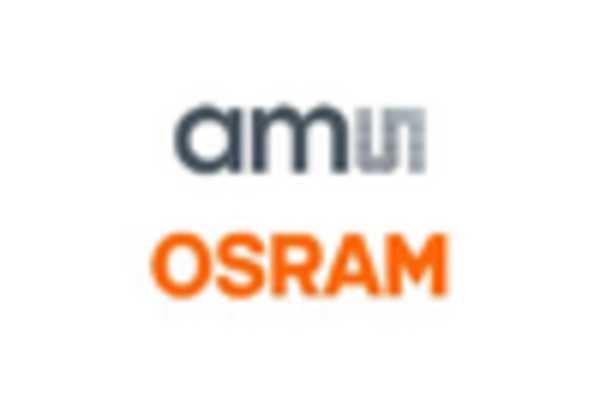Rising Awareness of Health and Well-being
The increasing awareness of health and well-being among consumers is influencing the market in Japan. Research indicates that lighting quality can significantly impact productivity, mood, and overall health. As businesses recognize the importance of creating conducive environments for employees, the demand for tailored lighting solutions that enhance well-being is on the rise. Lighting as-a-service models provide the flexibility to implement customized lighting systems that cater to specific needs, such as circadian lighting that adjusts to natural light patterns. This focus on health-oriented lighting solutions aligns with broader trends in workplace wellness and employee satisfaction. Consequently, the lighting as-a-service market is poised for growth as organizations seek to invest in lighting systems that promote health and productivity.
Urbanization and Infrastructure Development
Japan's ongoing urbanization and infrastructure development are pivotal drivers of the lighting as-a-service market. As cities expand and new urban areas emerge, the demand for efficient and adaptable lighting solutions increases. The government has invested heavily in smart city initiatives, which often include advanced lighting systems that can be managed remotely. According to recent data, urban areas in Japan are expected to grow by approximately 10% by 2030, necessitating innovative lighting solutions that can cater to diverse urban needs. Lighting as-a-service models offer flexibility and scalability, making them attractive to urban planners and developers. This trend indicates a shift towards integrated lighting solutions that enhance urban living while promoting energy efficiency, thus propelling the growth of the lighting as-a-service market.
Cost-Effectiveness and Financial Flexibility
Cost considerations are a primary driver for the adoption of lighting as-a-service models in Japan. Businesses are increasingly looking for ways to manage operational costs while maintaining high-quality lighting solutions. The lighting as-a-service market offers a financially attractive alternative by eliminating the need for large upfront investments. Instead, companies can pay a monthly fee that covers installation, maintenance, and upgrades. This model not only improves cash flow but also allows businesses to allocate resources more effectively. Recent studies indicate that companies utilizing lighting as-a-service can achieve energy savings of up to 30%, further enhancing the financial appeal. As organizations prioritize cost-effectiveness, the lighting as-a-service market is likely to experience substantial growth, driven by the demand for budget-friendly lighting solutions.
Government Initiatives for Energy Efficiency
The Japanese government has been actively promoting energy efficiency through various initiatives, which significantly impacts the lighting as-a-service market. Policies aimed at reducing energy consumption and carbon emissions have led to increased investments in energy-efficient technologies. For instance, the government has set ambitious targets to reduce greenhouse gas emissions by 26% by 2030 compared to 2013 levels. This regulatory environment encourages businesses to adopt innovative lighting solutions that align with national goals. Consequently, the demand for lighting as-a-service offerings, which provide energy-efficient lighting solutions without the upfront costs, is likely to rise. The government's commitment to sustainability not only fosters a favorable market landscape but also incentivizes companies to transition towards more efficient lighting systems, thereby driving growth in the lighting as-a-service market.
Technological Advancements in Lighting Solutions
Technological advancements play a crucial role in shaping the lighting as-a-service market in Japan. Innovations such as LED technology, IoT integration, and smart controls have transformed traditional lighting systems into dynamic, energy-efficient solutions. The adoption of LED lighting has surged, with estimates suggesting that LED penetration in the commercial sector could reach 80% by 2025. These advancements not only improve energy efficiency but also enhance the overall user experience through customizable lighting options. As businesses seek to modernize their facilities, the appeal of lighting as-a-service offerings, which provide access to the latest technologies without significant capital investment, becomes increasingly evident. This trend indicates a robust growth trajectory for the lighting as-a-service market, driven by the continuous evolution of lighting technologies.

















Leave a Comment